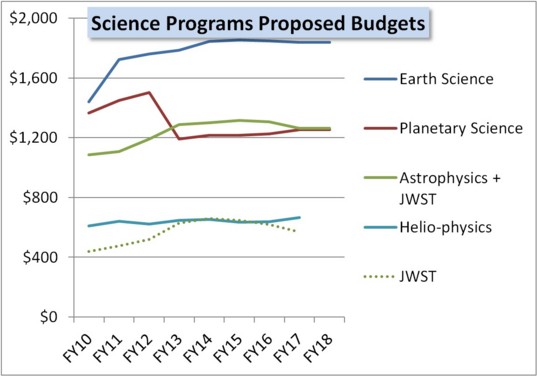By now you may have seen coverage of last year’s budget request and the sequestration and their negative effects on NASA’s Planetary Science Division (link to earlier post). Fast forward to the Continuing Resolution for 2013, and another picture emerged: one of strong public support for NASA’s tremendous accomplishments in planetary science, and a bipartisan message from Congress that a mission to Europa should be a major priority for the agency. The $75M included explicitly along with an overall $200M increase in NASA’s Planetary Science budget from Congress is a huge step forward in realizing the highest priority mission for the past two decades, a return to Europa (ranked equal to or separate from any Mars missions).
But the 2014 budget request showed that the Administration, and NASA, have a different idea: less money for Planetary Science and no mention of Europa anywhere to be found. What was there? A commitment to Human Exploration, continued funding for the Space Launch System and James Webb Space Telescope, and further Mars exploration. It’s clear: NASA and the President haven’t gotten our message.
Several key groups have weighed in on the subject. Before the president’s budget was released, Dr. Jim Green spoke to the NASA advisory Planetary Science Subcommittee, with a message that the worst was coming—a continuation of the bleak FY2013 proposal. “We are not a protected program, we are not a high-priority program,” he said.

Courtesy of Planetary Society: http://www.planetary.org/blogs/guest-blogs/van-kane/20130410-proposed-nasa-planetary-science-budget.html
Europa isn’t the only destination to suffer, but the whole Outer Planets program is taking a big hit, to the tune of nearly $45M from FY2012, including cutting Europa funding and decreasing funds for the active Cassini mission at Saturn. Discovery mission cadence is threatened by both cuts and by the sequestration. NASA’s valuable Education and Public Outreach programs are under fire as well: funding for teams working across the country at universities, national labs, educational organizations and NASA centers, are being reallocated to government organizations separated from spacecraft teams, mission science teams, and the active process of scientific and engineering achievement associated with NASA missions. The OMB description states, “The Budget includes a bold reorganization of Federal STEM programs that uses existing resources more effectively and in a more streamlined, consolidated way.” I can think of another word than “bold.” If this “restructuring” holds, it would be a bit like asking the University of Texas to do public relations and curriculum development for MIT.
So let’s look at what we’ve got right now: by the end of FY 2013, NASA has been required to spend $75 million on instrument maturation for Europa Clipper. It’s unclear yet what NASA’s FY2013 operations plan will show — that’s expected out in the next month. The possibilities include $75M spent on the instrumentation, or ~93% of $75M per the general cuts mandated by sequestration. Unfortunately, most of the increase in planetary science allocated by Congress, to the tune of $200M, could fall victim to sequestration as NASA maneuvers to keep it’s “priority” programs safe from feeling the effects of the sequester. But for the time being, it looks like upwards of $60M may be spent getting instruments ready for Europa, most of the development for which would actually happen during FY2014.
So, here’s our new action plan to get Europa Clipper funded with YOUR HELP!

1) A campaign to contact Congress that starts NOW.
We need to:
-Thank Congress for supporting Planetary Science, and specifically Europa!
-Ask Congress to again restore Planetary Science funding with continued Europa development, working towards a New Start
- Ask Congress to keep watch on the $75M Europa line item in NASA’s 2013 operations plan.
2) A year-long writing campaign contacting the White House and NASA Administration.
So far, the President and NASA have not taken notice of the public and industry-wide support for a new Europa mission. We need to make compelling arguments, based on science and societal impact for Europa to become a priority for NASA. While the President sets NASA’s direction, he relies on advisors and staff that includes the NASA Administration and President’s Council of Advisors on Science and Technology (PCAST). We’ve put together a list of people to contact, so please see the FY2014 Campaign HERE for those to contact. If we can encourage the President along with his advisors at NASA and PCAST to consider Europa Clipper as an inspiring, scientifically rich goal for NASA, we may reach the goal of a 2015 New Start!
The summary is this: the public is excited about Europa. Congress has been on our side–they’ve listened to the public and to planetary scientists and advocated for a Europa mission on our behalf. The President and his advisors have other priorities, but we are capable of turning the tide if we all do our part.
Let’s write our President, NASA and Congress and ask them to help us SET SAIL!
Britney Schmidt for
Destination:Europa